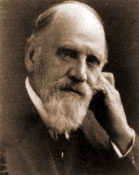Francis Darwin facts for kids
Quick facts for kids
Francis Darwin
|
|
|---|---|
 |
|
| Born | 16 August 1848 |
| Died | 19 September 1925 (aged 77) Cambridge, England
|
| Nationality | British |
| Known for | Phototropism |
| Spouse(s) |
Amy Richenda Ruck
(m. 1874; died 1876)Ellen Wordsworth Crofts
(m. 1883; died 1903)Florence Henrietta Fisher
(m. 1913) |
| Children | Bernard Darwin Frances Cornford |
| Parent(s) | Charles Darwin Emma Wedgwood |
| Scientific career | |
| Fields | Botany |
| Influences | Charles Darwin |
Sir Francis Darwin (born August 16, 1848 – died September 19, 1925) was a British botanist. He was the third son of the famous scientist Charles Darwin. Francis Darwin followed in his father's footsteps, becoming an important scientist himself.
Contents
A Life in Science: Francis Darwin's Journey
Francis Darwin was born in 1848 at Down House in Downe, Kent, England. He was the seventh child of Charles and Emma Wedgwood. He went to school at Clapham Grammar School.
Later, he studied at Trinity College, Cambridge. He first studied mathematics before switching to natural sciences. He graduated in 1870. He also studied medicine for a short time but decided not to become a doctor.
Family Life and Marriages
Francis Darwin was married three times during his life. His first wife was Amy Richenda Ruck, whom he married in 1874. Sadly, Amy died in 1876, just a few days after their son, Bernard Darwin, was born. Bernard later became a well-known golf writer.
In 1883, Francis married Ellen Wordsworth Crofts. They had a daughter named Frances Crofts Darwin in 1886. Frances grew up to be a poet. Ellen passed away in 1903.
His third wife was Florence Henrietta Fisher. They married in 1913, the same year Francis was made a knight.
Working with His Father: Plant Discoveries
Francis Darwin worked closely with his father, Charles Darwin. They did many experiments together, especially on how plants move. They were very interested in phototropism. This is how plants grow towards light.
They wrote a book together called The Power of Movement in Plants (1880). Francis also helped publish a new version of his father's book, Insectivorous Plants, after his father died.
Their experiments showed that the tip of a young grass seedling (called a coleoptile) helps it grow towards light. They did this by covering and uncovering parts of the seedlings. These discoveries later led to finding a plant hormone called auxin. Auxin helps control plant growth.
Honors and Later Work
Francis Darwin became a member of the Linnean Society of London in 1875. His father nominated him for this honor. In 1882, he was elected a Fellow of the Royal Society. This happened in the same year his father passed away.
After his father's death, Francis helped share Charles Darwin's work with the world. He edited The Autobiography of Charles Darwin (1887). He also put together several books of his father's letters. These included The Life and Letters of Charles Darwin (1887) and More Letters of Charles Darwin (1905).
Many universities gave Francis Darwin special honorary degrees. Cambridge University gave him a doctorate in science in 1909. He also received honors from universities in Dublin, Liverpool, and Prague, among others. In 1913, he was knighted, becoming "Sir Francis Darwin."
Sir Francis Darwin passed away in 1925 and was buried in Cambridge. His daughter, Frances Cornford, was later buried next to him.
See also
- Dorothea Pertz with whom he coauthored five papers


